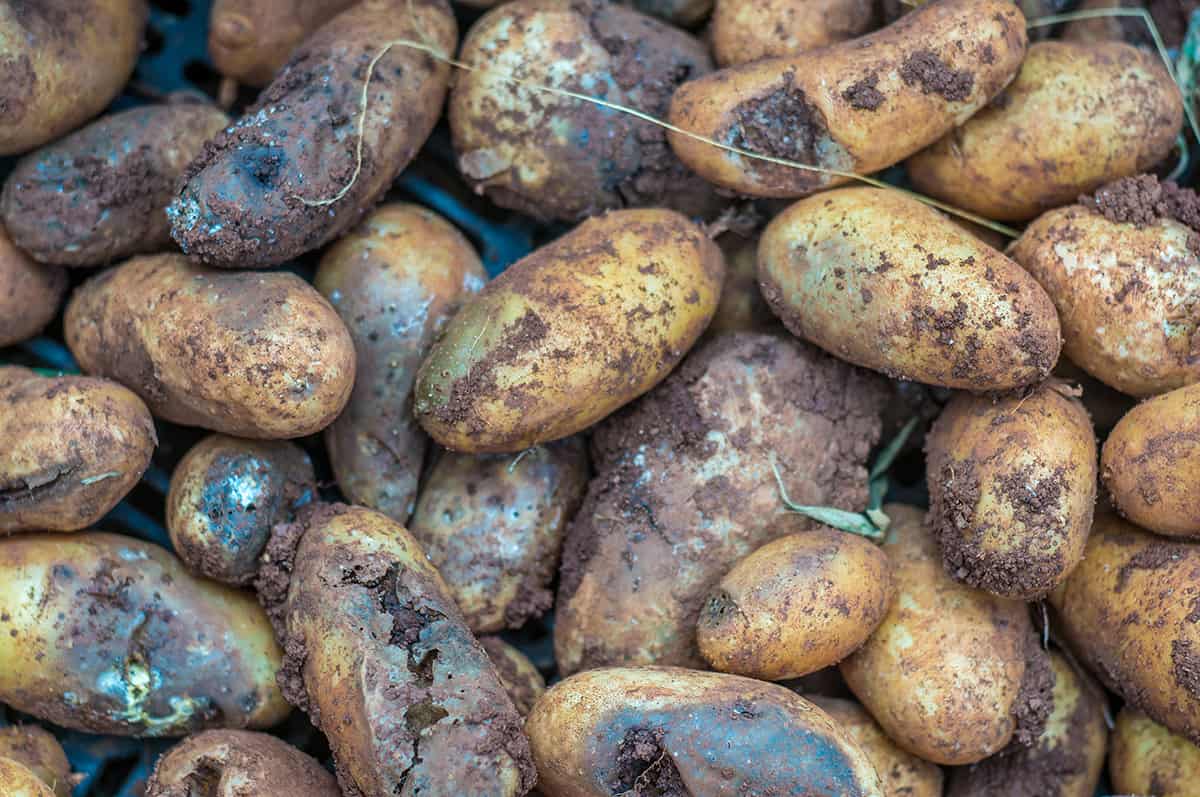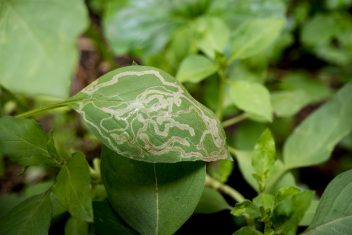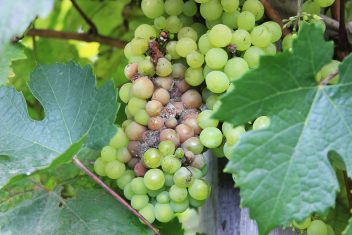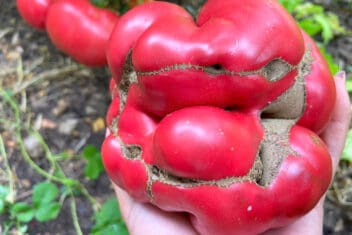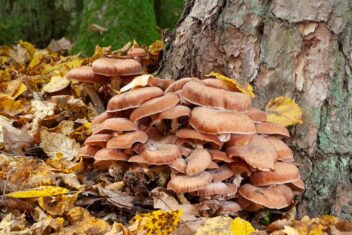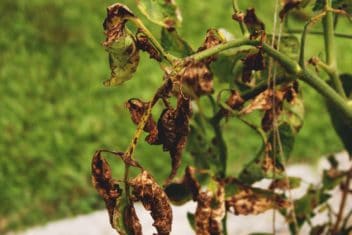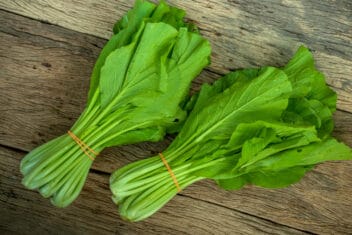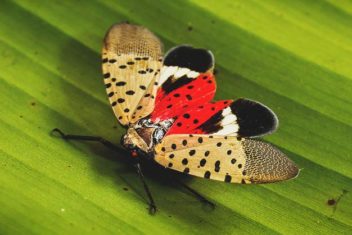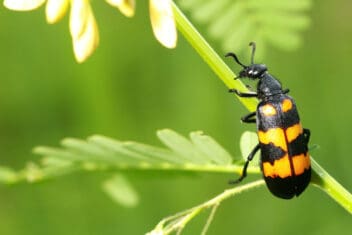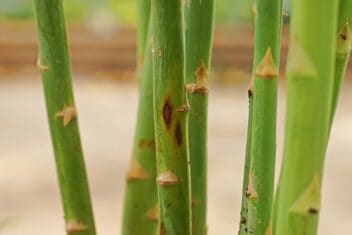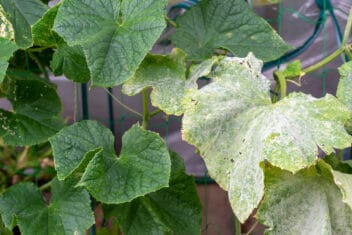Are your potato plants struggling? Your plants might have one of the most common potato plant pests and diseases. Potato plants are susceptible to a variety of pests and diseases that cause growth problems, defoliation, or even the death of your plants.
The first step is to figure out if you have one of these problems in your garden. Look for the typical symptoms, and then explore ways to get rid of the pests or diseases.
This guide will show you how to prevent, spot, or stop common problems.
7 Common Potato Plant Pests
Unfortunately, gardeners struggle with several potato plant pests. Make sure you use preventative pest measures to stop them from finding your garden. Cultural practices like crop rotation, cleaning plant debris, and sanitizing garden tools is key.
1. Aphids

It seems as if most lists of pests begin with aphids; they infest so many different types of plants. Winged aphids move into potato fields and beds in large numbers, and they start removing plant sap from the foliage. When aphids remove sap from the leaves, they leave behind a sticky residue called honeydew.
Small infestations aren’t a huge concern, but as the aphids grow in number, you’ll need to treat the problem. Natural enemies are one method for controlling the aphid population.
Take a look at our guide to getting rid of aphids in your garden.
2. Colorado Potato Beetle
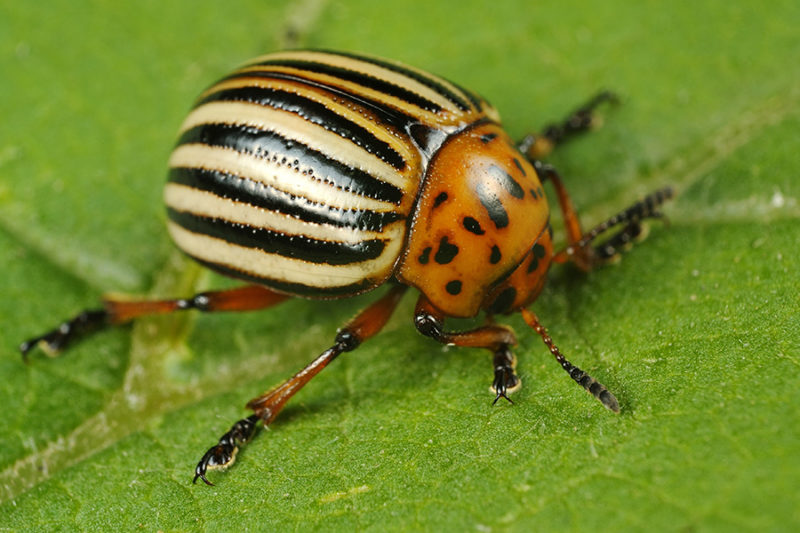
One of the most common potato plant pests is the Colorado potato beetle. This pest does damage in both the larval and adult forms; they’re general defoliators who chew through a plant’s leaves in no time. The early larvae cause less damage than the later stage, which is capable of defoliating an entire potato plant quickly.
Adult Colorado potato beetles are easy to identify. They have ten alternating orange and black lines that run along their back, and they lay clusters of bright orange eggs. Potato beetles overwinter in the garden, so infestations reoccur often.
Since these pests often overwinter, one of the best ways to control this beetle is crop rotation. Getting rid of an infestation is tricky once it happens, but Neem oil is an effective option that works great. Always hand-pick off the beetles and larvae that you spot, putting them in soapy water.
3. Cutworms
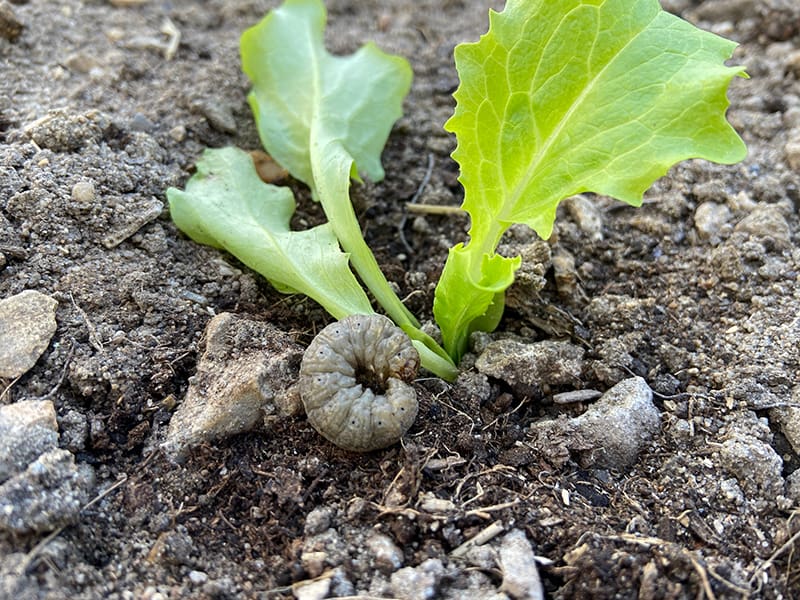
Young potato plants are vulnerable to cutworms that live in the soil. Cutworms eat through plants at the soil level, destroying plants in no time. If an infestation takes place later in the growing season, cutworms eat irregular holes into the leaves and tubers of the plant.
One of the problems with cutworms is that they are most active at night, so spotting them during the day is hard. You need to head out into the garden in the evening to be able to find these pests.
Take a look at our guide to cutworms in the garden.
4. European Corn Borer
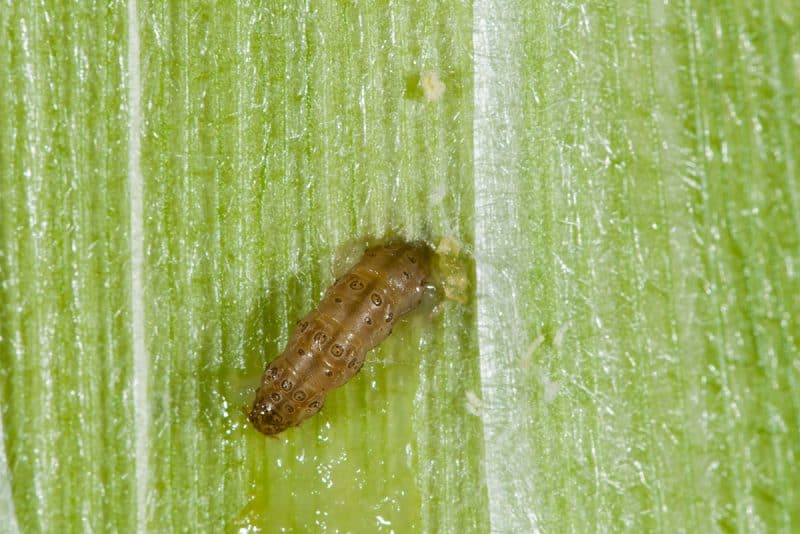
European corn borers aren’t as common as other potato plant pests, but they cause serious damage if they find your plants. They overwinter as larvae and pupate in the spring, and when they emerge, they bore into the stem after hatching. Once inside, they’re not easy to control; in fact, control is nearly impossible.
The problem is that, once the pests get inside the stem, they plug the entrance and start tunneling. Eventually, the stems die.
The only way to control European corn borers is to check the base of the plant regularly and remove the plants when you see the plugged stems. You can also use pheromone traps to capture the adults before they lay eggs.
5. Flea Beetles
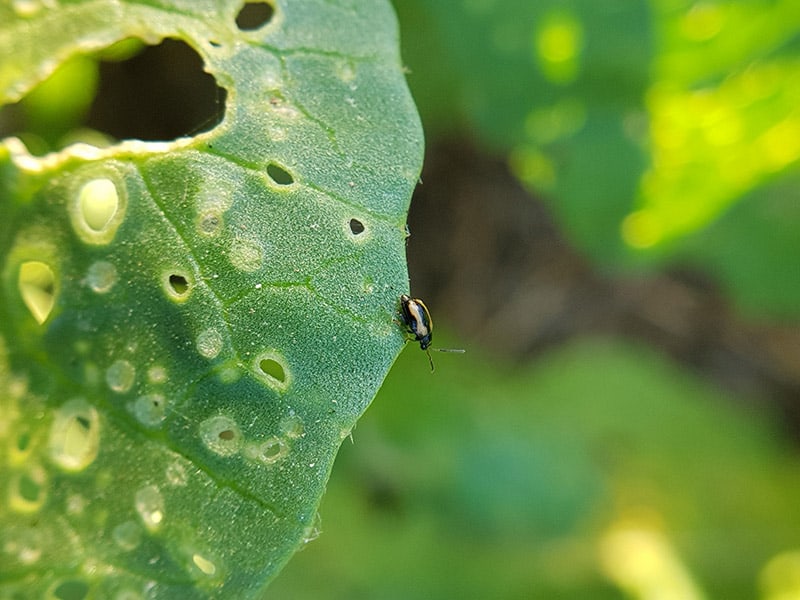
While potato diseases are a serious and easy-to-spot threat, some pests seem to be so small that they can’t be a big deal. But flea beetles shouldn’t be underestimated.
Flea beetles cause small holes or dents in the leaves; young plants are most vulnerable, but an infestation happens to any crop. A flea beetle infestation causes reduced plant growth, and severe infestations kill plants.
This pest is hard to spot. They’re small – measuring 1.5 to 3.0 mm – and dark colored; they jump from place to place.
If you’ve had flea beetles before, using floating row covers is one way to provide a barrier to protect young plants. Applying a thick layer of mulch helps prevent overwintering beetles from reaching the surface. You can use applications of diatomaceous earth and neem oil to control these pests effectively.
Take a look how to control flea beetles in your garden.
6. Potato Leafhopper
Potato leafhoppers are migratory pests that travel on the wind. They’re lime-green, and they lay eggs on the foliage of the potato plants that hatch into nymphs that are small and lime green.
These pests have a sucking mouthpart that they use to puncture the vascular tissue of the plant, sucking out the sap of the plants. One of the most common signs of a potato leafhopper infestation is hopper burns, small burns caused by the plant’s reaction to the leafhopper’s saliva.
Take a look at our guide to getting rid of leafhoppers in the garden.
7. Wireworms
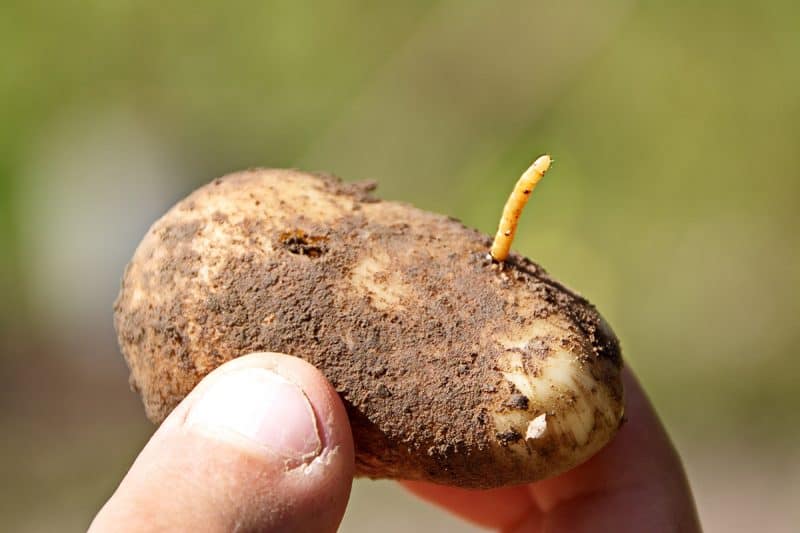
Another one of the most frustrating potato plant pests is wireworms, which attack germinating seeds, roots, and tubers. Wireworms are the larval stages of the click beetle, measuring around 3/4-inch long.
They overwinter in the soil as larvae and emerge as adults in the late spring. Then, the click beetles lay eggs on the soil, hatching out into wireworms. Wireworms typically create holes in the potatoes that happen when they burrow while feeding.
Typically, they don’t tunnel all the way through the tubers, but their damage results in reduced potato quality. Since these pests live in the soil, spotting them is hard. Cultivating the soil early in the spring helps to bring them to the surface, and introducing natural enemies is one way to get rid of wireworms.
7 Common Potato Plant Diseases
Unfortunately, many of the diseases that potato plants have are hard or impossible to treat. That’s why prevention is key. Remember to rotate crops, space them appropriately, water at the soil level, and clean up plant debris.
1. Bacterial Ring Rot
Bacterial ring rot is a bacterial disease that causes wilting stems and leaves. It causes the leaves to die, starting with the lower leaves first, and causes creamy yellow rings that turn into brown rotting spots inside of the tubers.
Getting rid of bacterial ring rot is nearly impossible once it begins. The bacteria enter the tubers through wounds and thrive in warm, wet soil. It overwinters in potato debris, so you have to make sure you remove all crop debris after harvesting your potatoes.
One of the only things that you can do is plant certified seed potatoes that grown in seed beds without ring rot.
2. Blackleg
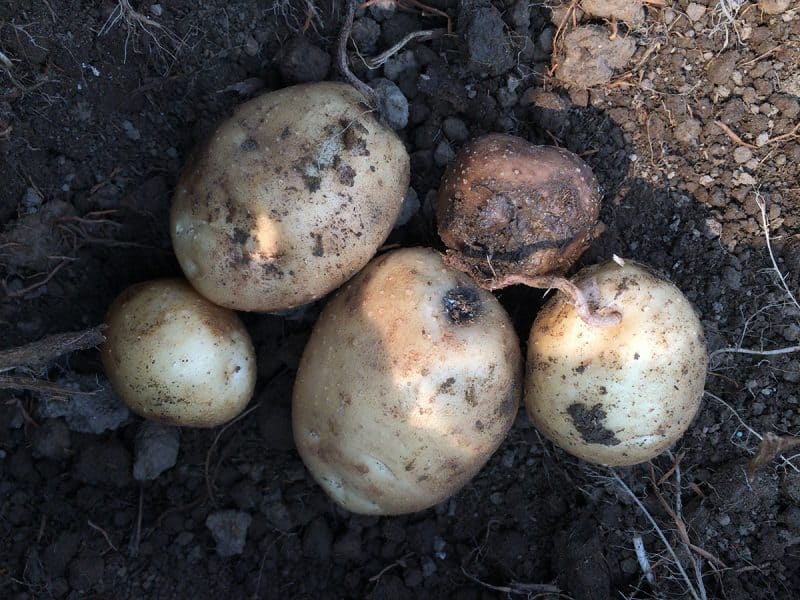
Blackleg is sometimes called soft rot. It leads to small, water-soaked lesions at the base of the stems. Over time, the lesions get larger, extending from the base of the stem to the canopy. The leaves become soft and water-soaked, turning from brown to inky black.
Over time, this bacterial disease causes the wilting and curling of the leaves. It’s carried in the tubers, spreading from infected to the healthy tubers. Potatoes with blackleg cannot be treated with chemical sprays, so preventative measures are the best and only way to avoid losing all of your plants to this bacterium.
Always use disease free seed potatoes, and use smart cultural practices, like crop rotation, removing infected plants, cleaning up plant debris, and avoid over-watering.
3. Common Scab
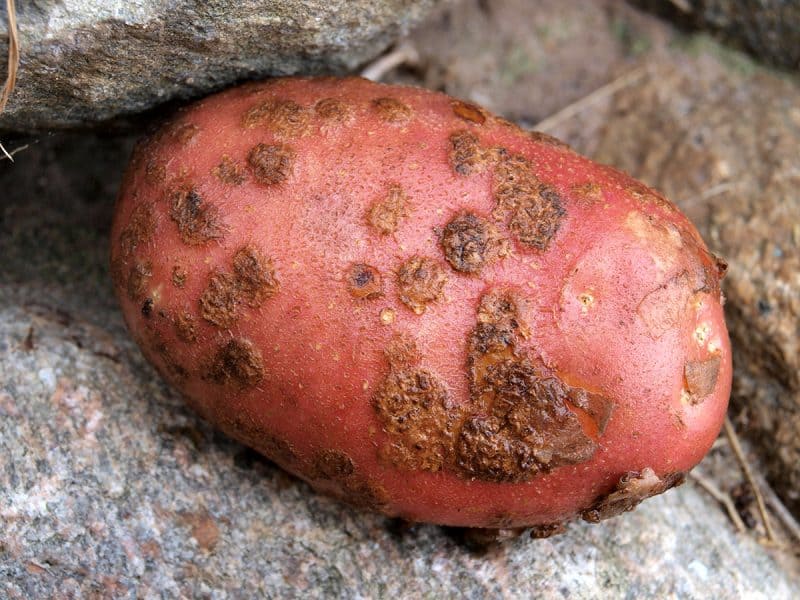
Common scab is a bacterium that causes raised, brown lesions with a strange, corky texture on the tubers. Eventually, the lesions turn brown or black with a straw-colored tissue underneath on the potatoes.
This bacterial disease is typically the worse during warm and dry conditions. It’s hard to manage, and preventing the disease requires several different methods. You need to use disease-free seed potatoes and practice crop rotation. Keeping the soil at a lower pH range also helps to prevent common scab.
4. Potato Early Blight
Potato early blight is a fungal disease that causes dark lesions with yellow borders that form rings of raised tissue on the leaves and stems. The leaves become necrotic, and on the potatoes, you’ll find dark, dry lesions on the tubers with a corky texture.
This fungal disease emerges during periods of high humidity. You can apply protective fungicides to reduce the symptoms. Make sure you fertilize and water your plants appropriately to reduce stress.
5. Potato Late Blight
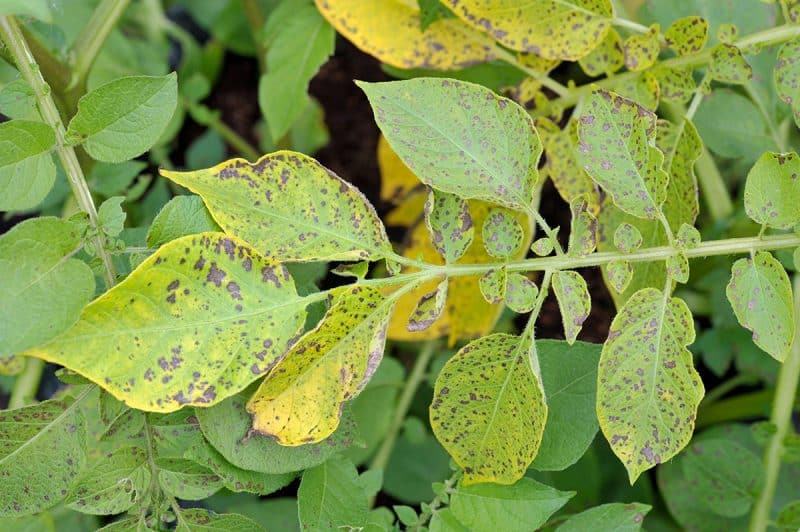
Potato late blight is caused by a pathogen that lives in the soil for years. It leads to a variety of symptoms, such as irregularly shaped brown lesions on the leaves in wet conditions. In dry conditions, the lesions dry up and turn dark brown.
Severely affected plants have a sweet, distinctive odor and red-brown lesions on the tubers that extend into the tissue of the potato.
Like tomato late blight, this pathogen is hard to control. You need to destroy infected tubers and use several applications of fungicides to help slow the spread of this disease.
6. Potato Leaf Roll
Potato leaf roll is one of the most common potato plant diseases; it’s a viral disease that causes young leaves to roll and turn yellow or pink. The lower leaves on the plants develop a leathery texture, and necrotic netting develops on the vascular tissue of the tubers. Over time, this viral disease causes the plants to have stunted growth.
Different aphid species transmit potato leaf roll. Since it’s a viral disease, there is no treatment, but using insecticides to stop an aphid infestation is a smart idea. Always remove and destroy infected plants and tubers to stop the spread of this virus throughout your garden.
7. Verticillium Wilt
Verticillium wilt is one of the most common potato plant diseases, and it causes the early death of the plants. This fungal disease causes leaflets to die on one side of the branching stem. If you cut through the stem of the plant, you’ll see discolored tissue.
Verticillium wilt appears when temperatures are high with a lot of moisture. It spreads quickly and is one of the most destructive fungal infections.
Check out our guide on verticillium wilt and how to spot it in your garden.
